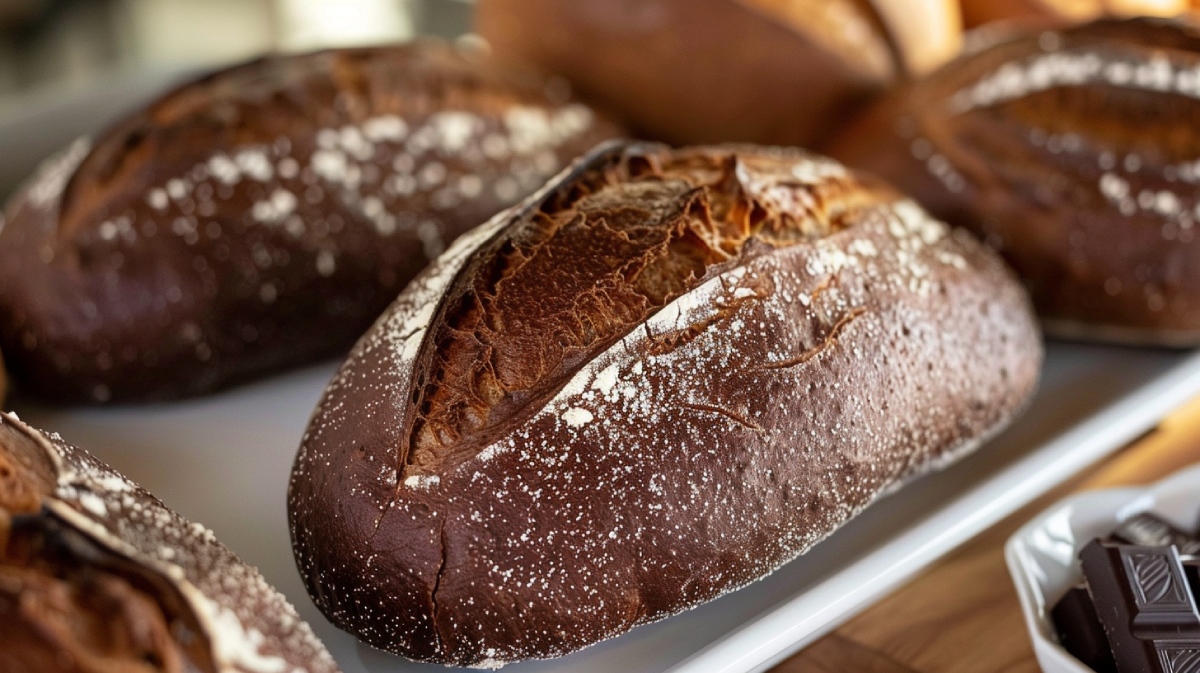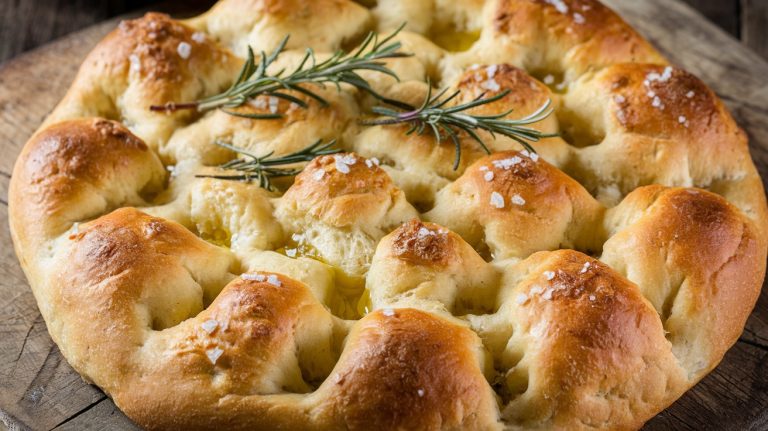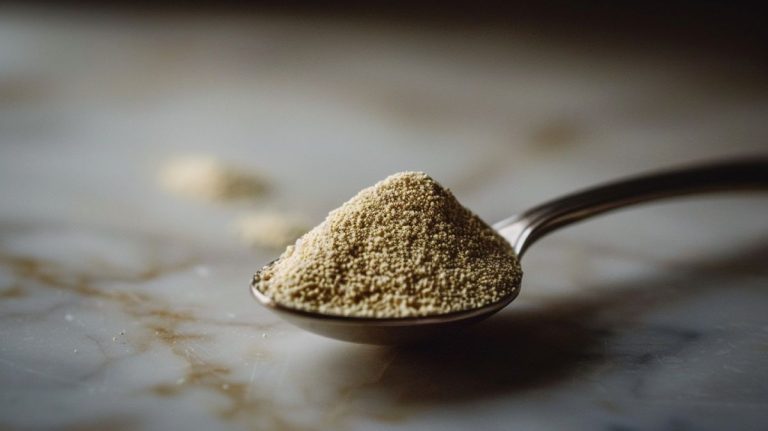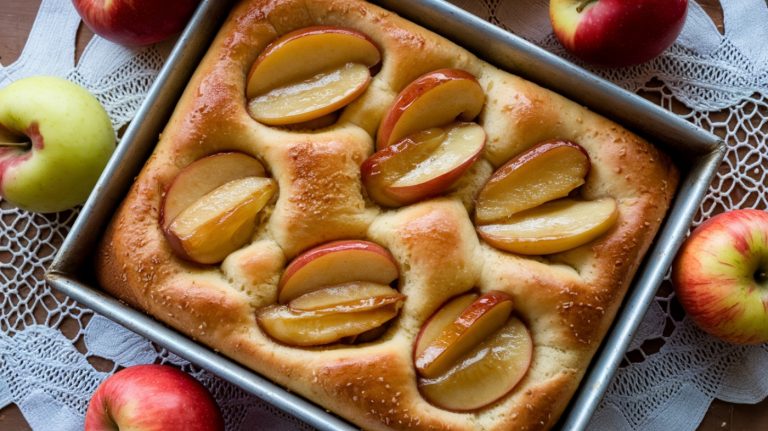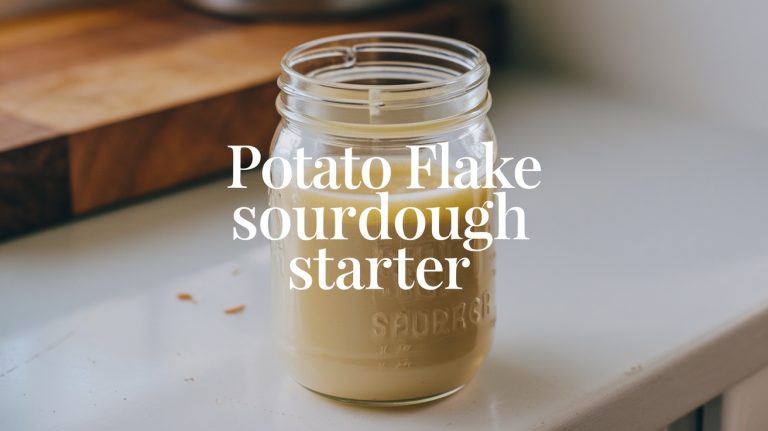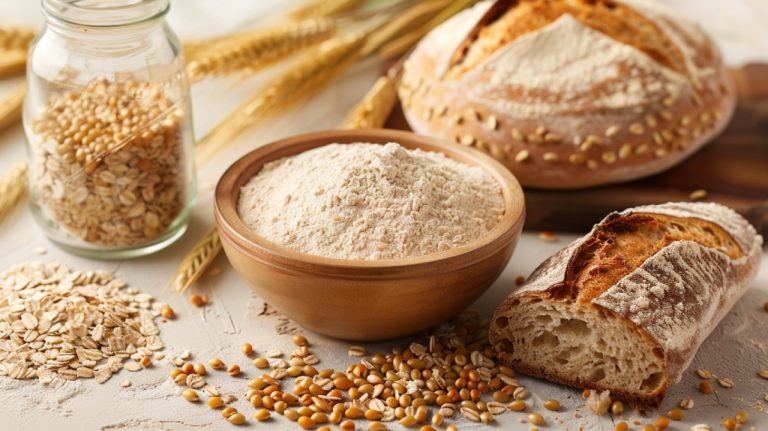How to Make Chocolate Sourdough Bread: Decadent Delights
To make chocolate sourdough bread, combine a vigorously active sourdough starter with a precise mix of unbleached all-purpose flour, whole wheat flour, and Dutch-processed cocoa. Use a digital scale for accuracy.
Employ the stretch and fold technique for robust gluten development every 30-60 minutes during bulk fermentation. Confirm the dough is covered and maintained at 78°F.
Bake in a Dutch oven, aiming for an internal temperature of 205°F. For enhanced flavor, incorporate techniques like autolyse and cold fermentation.
These advanced methods will yield a loaf with perfect texture and a rich, chocolatey taste. The following sections reveal more intricate steps.
Key Takeaways
- Use an active sourdough starter and feed it a few hours before mixing the dough.
- Mix flours, cocoa powder, and water, then rest for an hour to autolyse.
- Perform stretch and fold every 30-60 minutes during a 4-5 hour bulk fermentation.
- Shape the dough, incorporate chocolate chips, and allow it to be proofed before baking.
Recipe Overview and Appeal
Chocolate sourdough bread uniquely blends the tangy flavor of traditional sourdough with the rich, indulgent notes of cocoa powder and chocolate chips, offering a sophisticated twist on a classic favorite.
This recipe is designed for ease, employing the stretch and fold technique to develop gluten, ensuring a soft and chewy texture.
Each serving provides a balanced nutritional profile, with 227 calories, 6g of protein, and 3g of fiber.
The bread’s versatility allows it to be enjoyed at various mealtimes, whether for breakfast, brunch, snacks, or dessert.
Its community approval, reflected in an average rating of 4.51 from 426 votes, underscores its delicious flavor and texture.
This recipe is a must-try for any baking enthusiast.
Ingredients
You’ll need an active sourdough starter, unbleached all-purpose flour, whole wheat flour, Dutch-processed cocoa powder, brown sugar, filtered water, and chocolate chips to create this delectable chocolate sourdough bread.
Using high-quality Dutch-processed cocoa powder guarantees a rich chocolate flavor. Always use a kitchen scale for precise measurements, especially when incorporating flour and liquids for consistent dough consistency. Adjust brown sugar to your preference, typically around 50 grams. Optional inclusions like walnuts or dried fruits can enhance the texture and flavor.
| Ingredient | Amount |
|---|---|
| Active sourdough starter | 100 grams |
| Unbleached all-purpose flour | 300 grams |
| Whole wheat flour | 50 grams |
| High-quality cocoa powder | 40 grams |
| Brown sugar | 50 grams |
| Filtered water | 250 grams |
| Chocolate chips | 100 grams |
These components form the foundation of your rich, flavorful bread.
Essential Tools
To achieve perfect chocolate sourdough bread, you’ll need precise tools.
Start with a digital kitchen scale for accurate measurements and a ceramic or glass mixing bowl for ideal dough fermentation.
A banneton, Dutch oven, and dough scraper are also essential for shaping and baking, ensuring professional-quality results.
Accurate Measuring Instruments
Guaranteeing precise measurements in baking requires essential tools, like a digital kitchen scale. This scale secures consistency in your chocolate sourdough bread by accurately weighing ingredients.
Dry measuring cups for flour and cocoa powder and liquid measuring cups for water are used to maintain accurate measurements, which are vital for the dough’s hydration and structure.
A food thermometer is indispensable for checking the internal temperature, aiming for around 200°F to ascertain ideal doneness.
A dough scraper helps manage sticky dough and clean surfaces efficiently.
During proofing, a banneton or proofing basket supports high-hydration dough, aiding in achieving the desired crust and structure.
These instruments collectively enhance the baking process, guaranteeing your chocolate sourdough bread turns out perfect every time.
Optimal Baking Equipment
Investing in excellent baking equipment guarantees your chocolate sourdough bread achieves professional-quality results. Precise tools like a digital kitchen scale guarantee ingredient accuracy, vital for consistency. A Dutch oven captures steam, giving your bread a crusty exterior. Using a banneton supports your dough during its final rise, which is necessary for high-hydration sourdoughs. Employ a dough scraper to handle sticky dough efficiently without excess flour, maintaining the ideal texture. Finally, a thermometer guarantees your bread reaches 205°F, achieving ideal doneness.
| Tool | Purpose | Benefit |
|---|---|---|
| Digital kitchen scale | Accurate ingredient measurement | Consistent results |
| Dutch oven | Traps steam | Crusty exterior |
| Banneton | Supports dough shape | Necessary for high-hydration doughs |
| Dough scraper | Efficient dough handling | Maintains ideal texture |
Invest in these tools for superior chocolate sourdough bread.
Baking Tips for Chocolate Sourdough Bread
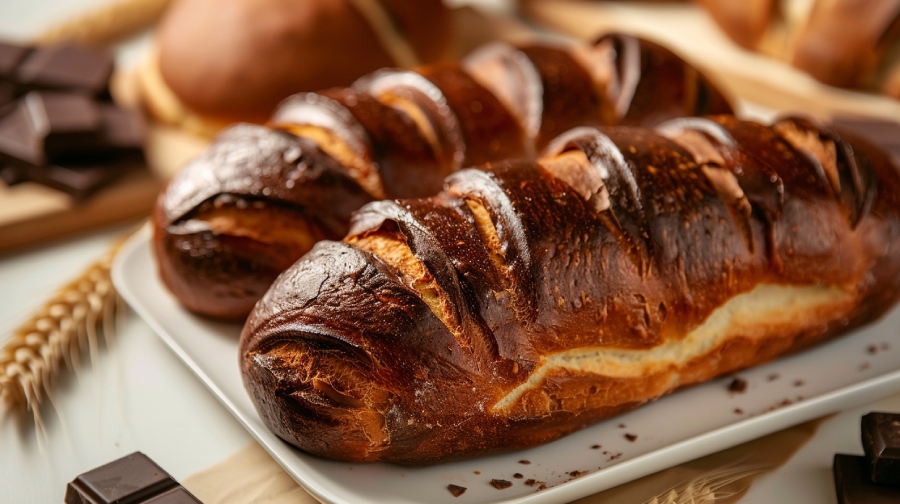
Mastering the art of chocolate sourdough bread hinges on precise ingredient measurements and the use of a vigorously active starter.
Start by feeding your sourdough starter a few hours before mixing the dough. This will facilitate proper hydration and achieve the right dough consistency.
During bulk fermentation, stretch and fold every 30-60 minutes to strengthen the dough structure. Incorporate chocolate chips evenly to enhance flavor distribution.
Preheat your oven to 500°F for at least 30 minutes to create the necessary steam for a crusty exterior. Monitor the internal temperature, aiming for around 205°F for ideal doneness.
Accurate measurements and attention to fermentation will yield a beautifully risen and flavorful chocolate sourdough bread.
Recipe Steps
To begin, you’ll mix active sourdough starter, filtered water, brown sugar, and vanilla before incorporating sifted all-purpose and whole wheat flour, cocoa powder, and salt to form a shaggy dough.
During the bulk fermentation phase, perform stretch and fold techniques every 30 minutes to develop gluten strength.
Mixing Ingredients Properly
Start by verifying your sourdough starter is active and bubbly before mixing it with filtered water and sugar in a large bowl until well combined.
Gradually sift in the unbleached all-purpose flour, whole wheat flour, and cocoa powder.
Mix until a shaggy dough forms, making sure no dry flour remains.
Incorporate chocolate chips by hand, gently kneading to distribute them evenly while avoiding excessive handling.
Allow the mixture to rest for 1 hour (autolyse) to enhance gluten development and improve dough structure.
After the autolyse, proceed with stretch and folds during the bulk fermentation phase, repeating every 30 minutes for about 2 hours to strengthen the dough.
This guarantees ideal gluten development and a well-structured loaf.
Bulk Fermentation Process
During bulk fermentation, keep the dough in a covered bowl at a warm 78°F, ensuring it remains hydrated and rises properly.
Perform the stretch and fold every 30 minutes to strengthen the dough structure and create air pockets. This process typically lasts 4 to 5 hours.
Monitor the dough for a slight increase in volume, about 30-40%, and look for bubbles forming at the bottom, which indicates proper fermentation. The dough should become aerated and light without necessarily doubling in size.
Keeping the bowl covered during bulk fermentation prevents the development of a crust, maintains ideal hydration, and promotes a significant rise.
This phase is vital for developing the flavor and texture of your chocolate sourdough bread.
Shaping and Baking
After bulk fermentation, transfer the dough onto a floured surface and shape it into a ball, allowing it to rest for 20-30 minutes to relax the gluten for ideal final shaping. For final shaping, flatten the dough into a rectangle, sprinkle half the chocolate chips, fold it like a letter, and roll it into a cylinder, pinching seams to maintain tension.
| Step | Action | Key Points |
|---|---|---|
| Preheat the oven | To 500°F | Guarantees proper baking temperature |
| Shape the dough | Place in floured banneton | Preserves shape during cold fermentation |
| Cold fermentation | Refrigerate dough overnight | Develops flavor |
| Baking | Cover dough, bake 20 minutes, uncover | Creates steam |
| Cool completely | Place on wire rack | Guarantees best texture and flavor |
Fermentation Techniques
Mastering fermentation techniques is essential for achieving exceptional chocolate sourdough bread’s complex flavors and airy texture.
Start with levain preparation, using a 1:1:1 ratio of sourdough starter, flour, and water.
Next, employ the autolyse technique by mixing flour and water and allowing the dough to rest for one hour, enhancing gluten development.
During bulk fermentation, maintain a temperature control around 78°F (26°C) and stretch and fold every 30-60 minutes to aerate the dough.
After 4-5 hours, proceed to cold fermentation by refrigerating the shaped dough for 12-24 hours.
This slow fermentation enhances the flavor profile and fermentation speed, resulting in a superior chocolate sourdough.
Baking Instructions
To achieve a perfect bake, preheat your oven to 500°F (260°C) with a Dutch oven inside.
After finalizing the bulk fermentation with stretch and fold techniques, shape the dough and place it in a floured banneton. Incorporate chocolate chips evenly throughout the dough. For the second rise, refrigerate the dough for 12-24 hours to enhance flavor.
Transfer the dough onto parchment paper, score the top, and bake covered in the preheated Dutch oven for 20 minutes. Then, uncover and bake for an additional 20-25 minutes until the crust is golden.
Verify the internal temperature reaches 200°F (93°C). Finally, let it cool on a wire rack for at least one hour before slicing.
Health Benefits
While savoring your freshly baked chocolate sourdough bread, it’s important to recognize the significant health benefits that accompany this delicious treat.
The fermentation process in sourdough breaks down gluten and phytic acid, enhancing nutrient absorption. Probiotics and lactic acid present in sourdough promote gut health and improve digestive function.
Additionally, sourdough has a lower glycemic index, helping manage blood sugar levels and reducing spikes post-meal. The use of whole grains increases fiber intake, supporting heart health and aiding in weight management.
Fermentation also boosts the bioavailability of essential nutrients like B vitamins, minerals, and antioxidants, offering extensive health advantages.
Embrace these benefits while indulging in your decadent chocolate sourdough creation.
Frequently Asked Questions
What Is the Secret to Good Sourdough Bread?
To make good sourdough bread, you need an active starter, precise hydration, proper gluten development through stretching and folding, a warm fermentation environment, and precise scoring. Each step guarantees ideal texture, rise, and flavor.
Does Cocoa Powder Affect Yeast?
Yes, cocoa powder affects yeast by altering the dough’s pH, but moderate use won’t inhibit yeast activity. For ideal fermentation, balance cocoa with other ingredients, use proper hydration, and employ techniques like stretch and folds.
Is It Cheaper to Make Your Own Sourdough Bread?
Making your own sourdough bread costs roughly $1 to $2 per loaf, compared to $5 to $10 for store-bought. By leveraging bulk ingredient purchases and fermentation techniques, you maximize savings and produce artisanal-quality bread.
What Is the Best Flour to Make Sourdough Bread?
It would be best if you used bread flour to make sourdough bread. Its high protein content guarantees ideal gluten development, resulting in a robust crumb and chewy texture. All-purpose flour works too, but bread flour provides superior structure and consistency.
Masterpiece or Experiment? Discover What Your First Bite Reveals
You now have the recipe, tools, and techniques to make extraordinary chocolate sourdough bread.
Imagine the aroma filling your kitchen, the first crack of the crust, the rich, velvety chocolate mingling with the tangy sourdough.
Will your first bite disclose a perfectly balanced masterpiece or a new experiment to refine?
Only one way to find out—your sourdough journey begins now.
What delicious secrets will your loaf reveal?

